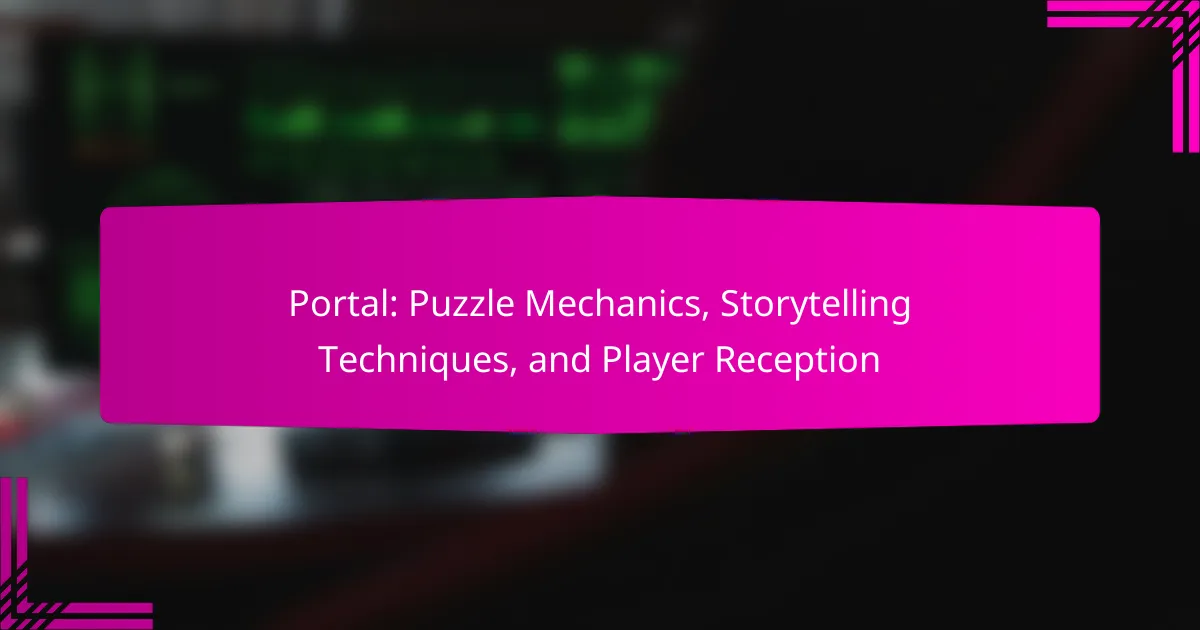Portal offers innovative puzzle mechanics that challenge players through spatial manipulation and environmental interactions. Its storytelling techniques engage players emotionally, unfolding narrative elements through gameplay. Player reception highlights the game’s unique blend of humor and existential themes, contributing to its acclaim. The article explores these core mechanics, storytelling approaches, and the impact on player experience.
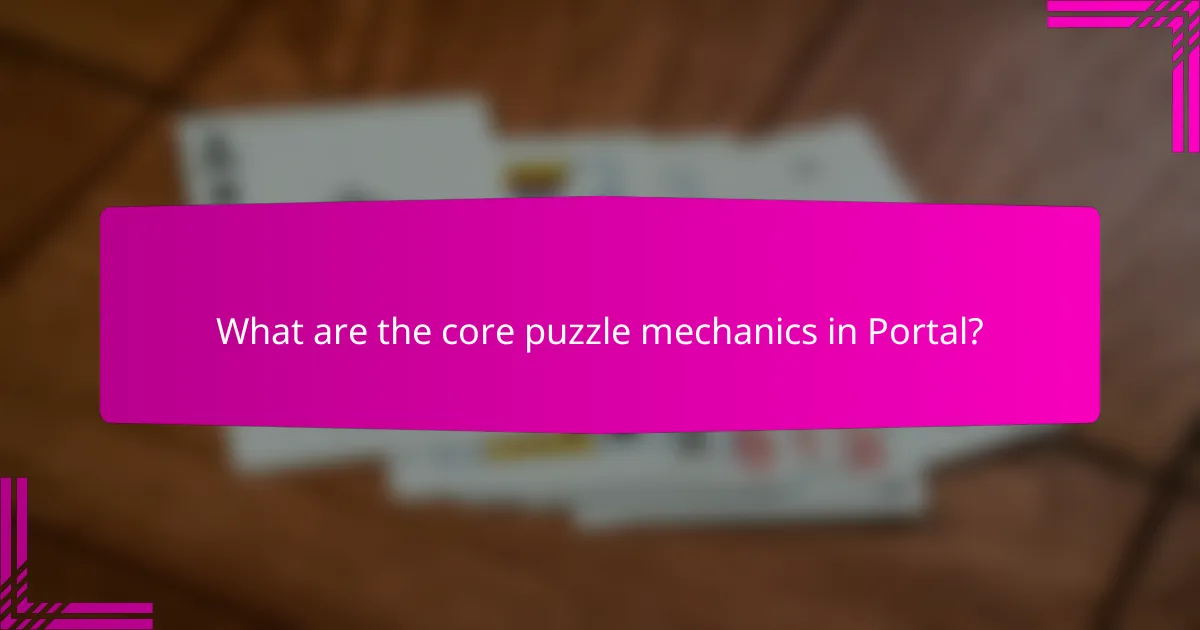
What are the core puzzle mechanics in Portal?
The core puzzle mechanics in Portal include the use of a portal gun, spatial manipulation, and environmental interactions. Players create portals to solve challenges, navigate spaces, and overcome obstacles. The mechanics emphasize physics-based gameplay, allowing players to think creatively. Unique attributes like momentum transfer add depth, enhancing the puzzle-solving experience.
How does the portal gun function in gameplay?
The portal gun functions by creating linked portals on flat surfaces, allowing players to teleport between them instantly. This mechanic enables unique puzzle-solving opportunities and enhances the game’s spatial dynamics. Players use the gun to navigate environments creatively, solving challenges that require thinking beyond traditional movement. The gun’s ability to manipulate space is a core element of the gameplay experience, contributing to the game’s innovative design and player engagement.
What role do environmental puzzles play in player engagement?
Environmental puzzles significantly enhance player engagement by fostering critical thinking and exploration. These puzzles challenge players to interact with the game world, promoting immersion through problem-solving. The unique mechanics in Portal, such as the use of portals to navigate environments, require players to think creatively, deepening their connection to the narrative. Additionally, the satisfaction of solving complex puzzles contributes to a rewarding gameplay experience, encouraging players to continue exploring the story. This engagement is further amplified by the seamless integration of puzzles into the game’s overarching themes and storytelling techniques.
Which strategies enhance problem-solving in Portal?
Effective strategies to enhance problem-solving in Portal include mastering spatial awareness, utilizing the portal gun creatively, and experimenting with environmental elements. Players benefit from understanding the physics mechanics, which are integral to puzzle solutions. Collaboration and sharing insights with others can also improve problem-solving skills, as diverse perspectives often reveal new approaches. Emphasizing trial and error fosters resilience and adaptability in overcoming challenges.

How does storytelling shape the player experience in Portal?
Storytelling in Portal profoundly enhances player experience by creating emotional engagement and immersive gameplay. The narrative unfolds through environmental storytelling and character interactions, particularly with the AI, GLaDOS. Players uncover the story as they solve puzzles, fostering a sense of discovery and curiosity. This integration of storytelling and gameplay mechanics results in a unique player journey, where each puzzle solved deepens the narrative understanding. The minimalist yet impactful storytelling approach allows players to interpret the story at their own pace, making the experience personal and memorable.
What narrative techniques are employed to convey the plot?
“Portal” employs various narrative techniques to effectively convey its plot. Key methods include environmental storytelling, clever dialogue, and character development through the AI, GLaDOS. Environmental storytelling immerses players in the game’s world, revealing backstory through the design of test chambers and hidden areas. Dialogue, often darkly humorous, enhances character depth and provides context. GLaDOS’s evolving relationship with the player adds tension and intrigue, driving the narrative forward. These techniques create a rich narrative experience that complements the gameplay mechanics.
How do character interactions impact the storyline?
Character interactions significantly shape the storyline by influencing plot development and player engagement. In “Portal,” these interactions create emotional connections and drive narrative progression. The dialogue between characters, particularly between the player and GLaDOS, enhances the storytelling experience. This dynamic not only reveals backstory but also provides context for the game’s puzzles. As a result, character interactions serve as a catalyst for both gameplay mechanics and narrative depth, enriching the overall player experience.
Which themes are prevalent in Portal’s narrative?
Portal’s narrative features themes of isolation, artificial intelligence, and dark humor. The protagonist’s journey highlights the struggle against oppressive systems through clever puzzle mechanics. The use of GLaDOS as an antagonist embodies the theme of technology gone awry, merging storytelling with gameplay. Player reception often praises the innovative blend of narrative and gameplay, creating a memorable experience.

What factors contribute to player reception of Portal?
Player reception of Portal is influenced by its innovative puzzle mechanics, engaging storytelling, and unique gameplay experience. The game’s core mechanics, such as the portal gun, offer a fresh approach to problem-solving, enhancing player interaction. Additionally, the narrative cleverly intertwines humor and existential themes, creating emotional resonance. The minimalist design allows players to focus on puzzles, further improving immersion. Overall, these factors contribute to the game’s acclaim and lasting impact on the puzzle genre.
How does player feedback influence game design?
Player feedback significantly influences game design by shaping mechanics, storytelling, and overall player experience. Developers analyze feedback to refine puzzle difficulty, enhance narrative depth, and improve engagement. For example, in “Portal,” player insights led to adjustments in puzzle complexity and narrative pacing, ensuring a more satisfying gameplay experience. This iterative process helps create a game that resonates with players, enhancing retention and enjoyment.
What role does community engagement play in the game’s success?
Community engagement significantly enhances the game’s success by fostering player loyalty and encouraging collaborative problem-solving. Engaged communities contribute to shared experiences, amplifying word-of-mouth promotion. Players often develop deeper connections to the narrative and mechanics, enhancing overall enjoyment. Additionally, feedback from the community can lead to game improvements, ensuring it evolves alongside player expectations. This dynamic interaction creates a positive cycle of engagement and satisfaction, reinforcing the game’s longevity and appeal.
Which aspects of gameplay are most praised by players?
Players most praise the innovative puzzle mechanics and engaging storytelling techniques in Portal. The game’s unique use of spatial reasoning challenges players while weaving a compelling narrative. Players appreciate the seamless integration of humor and dark themes, enhancing the overall experience. Additionally, the minimalist design allows for focused gameplay, fostering a strong connection to the puzzles and story.
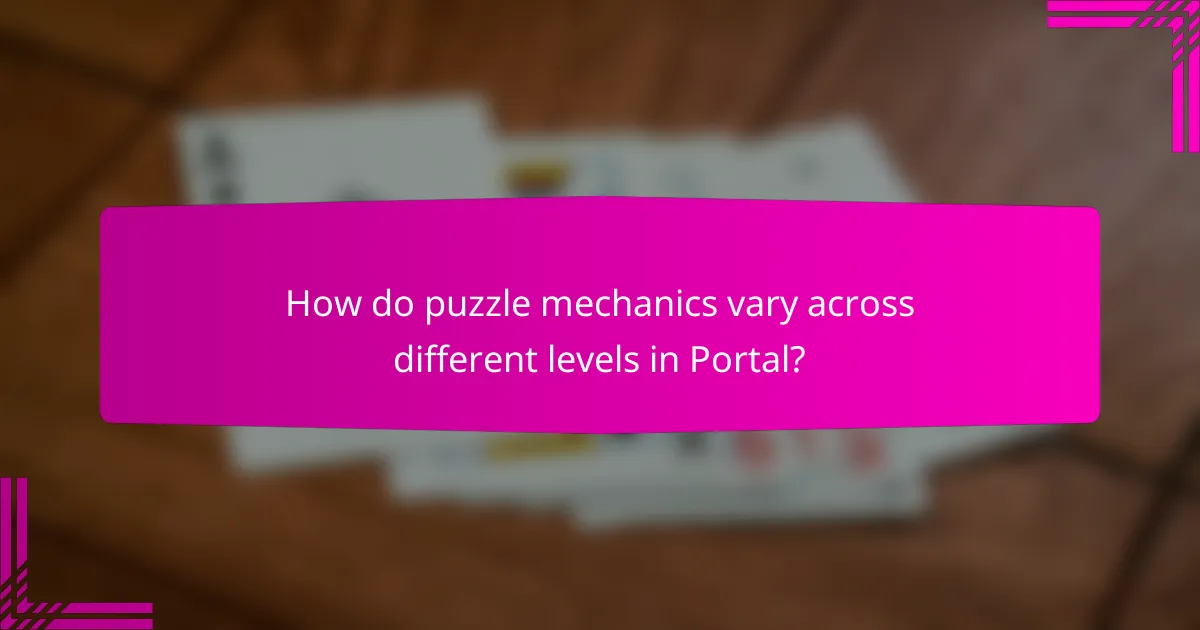
How do puzzle mechanics vary across different levels in Portal?
Puzzle mechanics in Portal vary significantly across levels, introducing new challenges and dynamics as players progress. Early levels focus on basic concepts like portals and momentum, while later levels integrate advanced mechanics such as turrets, energy balls, and timed challenges. Each level builds on previous knowledge, requiring players to adapt their strategies. The complexity increases, fostering critical thinking and problem-solving skills. Unique attributes, like the incorporation of narrative elements through environment design, enhance player engagement and storytelling.
What unique challenges are presented in advanced levels?
Advanced levels in Portal present unique challenges that test player skills and creativity. Players must master complex puzzle mechanics that often require innovative thinking and precise execution. The integration of storytelling techniques adds layers of narrative that can influence puzzle-solving strategies. Additionally, player reception varies, as some may find the difficulty rewarding while others may feel frustrated by the increased complexity.
How does difficulty scaling affect player retention?
Difficulty scaling positively impacts player retention by ensuring challenges remain engaging. Properly calibrated difficulty keeps players motivated and reduces frustration. A gradual increase in complexity encourages skill development, enhancing satisfaction. Games like Portal utilize this principle, balancing puzzles with narrative progression to maintain interest. Effective difficulty scaling fosters a sense of achievement, which is crucial for long-term player engagement.
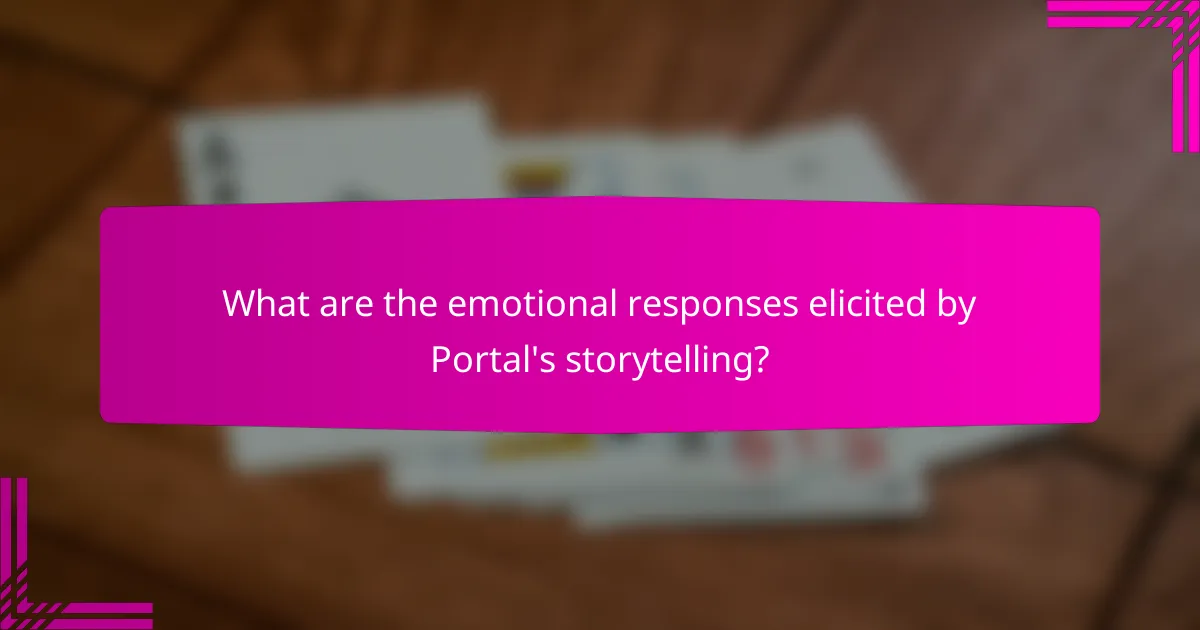
What are the emotional responses elicited by Portal’s storytelling?
Portal’s storytelling elicits a range of emotional responses, primarily through its unique blend of humor, tension, and existential themes. Players often experience curiosity as they uncover the narrative behind the Aperture Science facility. The dark humor, delivered by the AI character GLaDOS, creates moments of levity amidst the tension, fostering a sense of unease and engagement. Additionally, the themes of isolation and betrayal resonate deeply, prompting players to reflect on their own experiences. This emotional complexity enhances player immersion and strengthens the overall impact of the game.
How do players connect with the game’s characters?
Players connect with the game’s characters through immersive storytelling and engaging puzzle mechanics. The narrative unfolds in a way that allows players to form emotional attachments to characters like GLaDOS and Chell. The unique attributes of these characters, such as GLaDOS’s dark humor and Chell’s silent resilience, enhance player investment. Additionally, the game’s environment and puzzles reflect character motivations, creating a cohesive experience that deepens the connection. Players often reflect on their journey and interactions, reinforcing their bond with the characters throughout the gameplay.
Which moments in the game evoke strong emotional reactions?
Key moments in Portal that evoke strong emotional reactions include pivotal story revelations, character interactions, and gameplay challenges. Players often feel a mix of humor and tension during encounters with GLaDOS, particularly when her true intentions are revealed. The final escape sequence elicits a sense of triumph and relief, marking a significant emotional climax. Additionally, moments of player failure, such as unexpected deaths, can provoke frustration or determination, enhancing overall engagement with the narrative and mechanics.
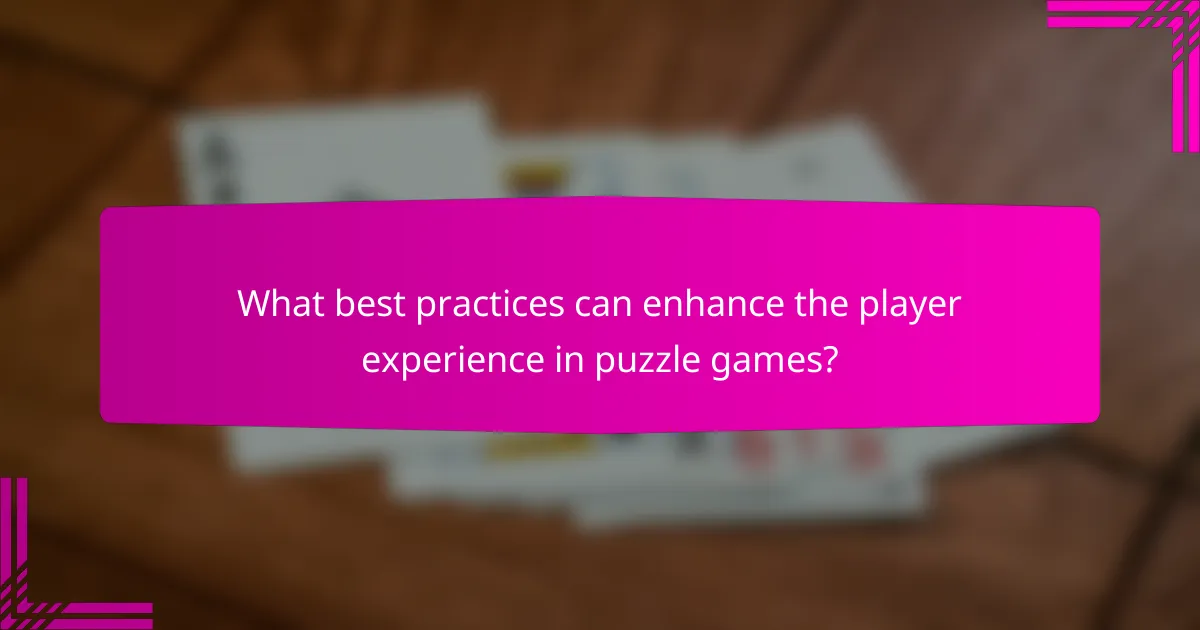
What best practices can enhance the player experience in puzzle games?
To enhance player experience in puzzle games like Portal, focus on intuitive mechanics, engaging storytelling, and responsive feedback.
Intuitive mechanics ensure players quickly understand game rules and controls, fostering a sense of achievement. Engaging storytelling immerses players, creating emotional connections with characters and the game world. Responsive feedback reinforces player actions, guiding them and enhancing satisfaction.
Additionally, incorporating varied difficulty levels caters to both novice and experienced players. Regular updates and community engagement can also improve player retention and satisfaction.
How can developers balance challenge and accessibility in puzzle design?
Developers can balance challenge and accessibility in puzzle design by incorporating varied difficulty levels and adaptive mechanics. By offering multiple solutions to puzzles, players with different skills can engage meaningfully. Playtesting with diverse audiences helps identify barriers, ensuring that challenges remain enjoyable without being frustrating. Additionally, clear visual and auditory cues can guide players, enhancing comprehension without diminishing the challenge.
What common mistakes should be avoided in creating engaging narratives?
To create engaging narratives, avoid common mistakes such as neglecting character development, failing to establish a clear conflict, and disregarding pacing. These elements are crucial for maintaining player interest in puzzle mechanics and storytelling techniques. Additionally, ensure that the narrative aligns with the gameplay experience. Inconsistent themes can confuse players and diminish their overall reception.
Which strategies can improve player feedback mechanisms?
To improve player feedback mechanisms, developers should implement regular surveys, integrate in-game feedback prompts, analyze player behavior data, and foster community discussions. These strategies enhance player engagement and provide valuable insights for game development.
Regular surveys allow developers to gather structured feedback directly from players, ensuring that their voices are heard. In-game feedback prompts can capture player sentiments immediately after gameplay moments, leading to more accurate responses. Analyzing player behavior data offers a quantitative approach to understanding player experiences, identifying pain points, and enhancing gameplay. Lastly, fostering community discussions creates a platform for players to share their thoughts and suggestions, building a stronger player-developer relationship.
